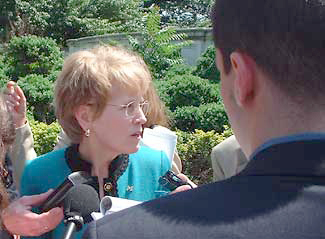As members of the U-M legal team continue to digest the June 23 Supreme Court decisions on the admissions lawsuits, one observation they’ve made is that in writing the majority opinion, Justice Sandra Day O’Connor relied heavily on the social science research and amicus briefs submitted on behalf of the University.
O’Connor’s use of information from the more than 75 briefs explaining the importance of affirmative action to the nation’s institutions was heartening for Vice President and General Counsel Marvin Krislov and his staff members, who worked to coordinate the more than 300 organizations that came forward asking to support the University by submitting legal briefs.

“We hoped the briefs would help justices see the importance of affirmative action but were pleasantly surprised by the number of them that were highlighted in the opinion,” Krislov says.
Although it is not unusual for the court to cite amicus briefs, O’Connor relied on them more than most, says University of California, Los Angeles, Law Professor Kenneth Karst.
“She’s telling you, ‘Look, the country has basically come to accept this [affirmative action],'” Karst says. “She’s looking around and seeing that this is the enlightened opinion out there. This is somebody who wants to pay attention to the context and what is happening in the lives of real people.”
In its decisions announced a week ago, the Supreme Court held in Grutter v. Bollinger, et al., the case against the Law School, that diversity is a compelling interest in higher education, and that race is one of many factors that can be taken into account to achieve the educational benefits of a diverse student body.
In the majority opinion (5-4) written by O’Connor, the court said the individualized review of applications to the Law School meets the requirements of a narrowly tailored system that does not constitute an illegal quota. The court found that the Law School “engages in a highly individualized holistic review of each applicant’s file, giving serious consideration to all the ways an applicant might contribute to a diverse educational environment.”
On the other hand, justices said the undergraduate admissions policy challenged in Gratz, et al. v. Bollinger, et al., which gives 20 points to racial and ethnic minority applicants, does not meet the court’s definition of narrowly tailored, says Assistant General Counsel Jonathan Alger. “But overall we consider it a significant win because they agreed diversity is a compelling state interest that can justify the consideration of race as one of many factors in university admissions,” Alger says.
“Only two justices, Antonin Scalia and Clarence Thomas, explicitly disagreed with the fundamental principle enunciated by the majority in both cases and asserted that, in their view, the educational benefits of a diverse student body do not constitute a compelling interest,” he says.
One of the things that pleased Dean-elect Evan Caminker about the outcome of the Law School case is that the court said U-M had proven its point that diversity is good for the learning environment. Social science research conducted by scholars at U-M and other universities helped show the value of diversity in education, he says.
“The court found that the educational benefits of diversity ‘are not theoretical but real,’ and had been ‘substantiated by the University and its amici,'” says Caminker, quoting the Grutter opinion. “Those benefits include ‘cross-racial understanding’ and the breaking down of racial stereotypes. The court cited the research we presented showing that diversity promotes learning outcomes, and better prepares students for an increasingly diverse workforce and society, and better prepares them as professionals,” he says.
“These benefits are ‘important and laudable,’ because ‘classroom discussion is livelier, more spirited, and simply more enlightening and interesting’ when the students have ‘the greatest possible variety of backgrounds,'” O’Connor wrote in the majority opinion in Grutter.
The court also held that “race-conscious admissions policies must be limited in time,” and said universities should consider periodic reviews for such programs. O’Connor concluded by suggesting that 25 years from now such programs no longer should be necessary.
Krislov says the University will have to consider how to structure a review process and how to work with others toward O’Connor’s goal of eliminating the need for affirmative action. The July 21 issue of the Record will include a talk with education experts and historians on what it will take to work toward that goal in the next quarter century.
More coverage of the Supreme Court decision
- Supreme Court decisions uphold affirmative action
- Supreme Court portrait
- LSA admissions policies to change
- Students celebrate ‘Unity, diversity, a better university’
- What others are saying
- The legal team: Marvin Krislov
- The legal team: John Payton
- The legal team: Jonathan Alger
- The legal team: Maureen Mahoney
- The legal team: Evan Caminker
- The legal team: Jeffrey Lehman
- The legal team: Charlotte Johnson
- The legal team: Liz Barry
- Excerpts from the Law School opinion
- Excerpts from the undergraduate opinion
- Scenes from the Supreme Court

